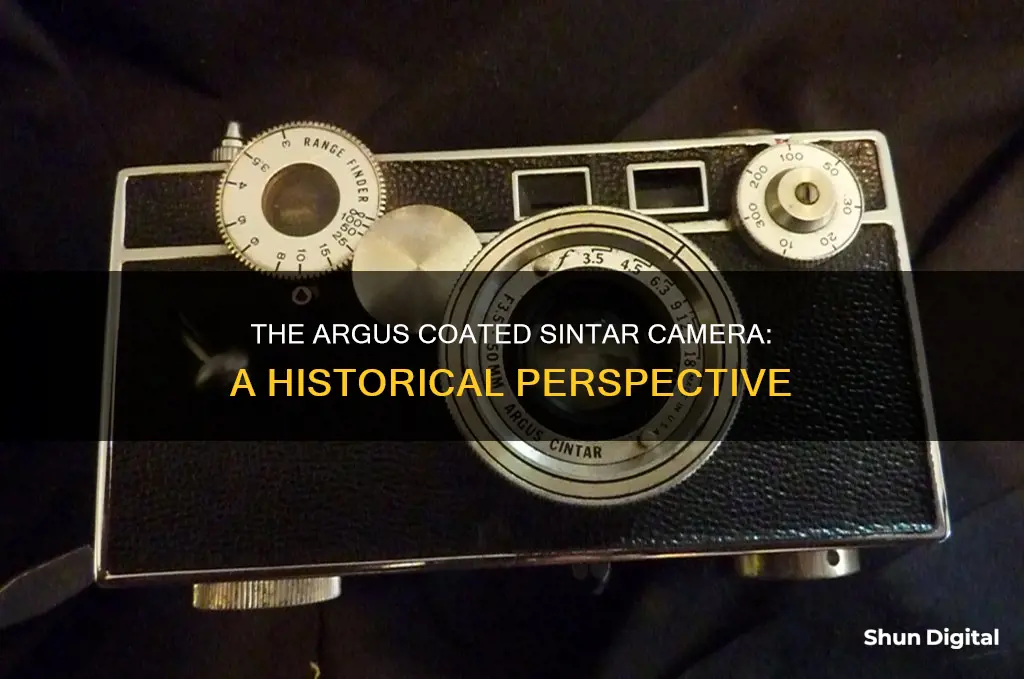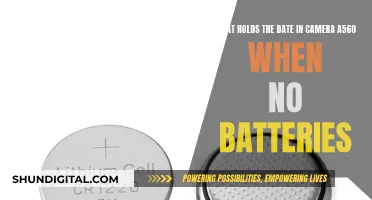
The Argus C3 was a low-priced rangefinder camera mass-produced from 1939 to 1966 by Argus Inc. in Ann Arbor, Michigan, USA. The camera came equipped with a 50mm f/3.5 Cintar anastigmat triplet lens. The Argus C3 was an improved version of the C (1938) and C2 (1938-1942) models, all three of which shared the same brick design. The C3 added built-in flash synchronisation and was otherwise identical to the C2. The C3 proved to be a huge success, selling approximately 2 million units during its 27-year production run.
| Characteristics | Values |
|---|---|
| Company | Argus Inc. |
| Location | Ann Arbor, Michigan, USA |
| Years Active | 1936-1966 |
| Founder | Charles Verschoor |
| Parent Company | International Research Corporation |
| Parent Company's Parent | International Radio Corporation |
| First Camera | Argus A |
| First Camera Patent Year | 1936 |
| First Camera Release Year | 1936 |
| Best-Known Model | Argus C3 |
| Nickname | The Brick |
| Number of C3s Sold | 2.2 million+ |
| Years C3 was Produced | 1939-1966 |
What You'll Learn
- The Argus C3 was a low-priced camera mass-produced from 1939 to 1966
- The Argus A was the company's first camera, released in 1936
- The Argus C and C2 were released in 1938
- The Argus C3 was equipped with a 50mm f/3.5 Cintar anastigmat triplet lens
- The Argus C3 was constructed primarily of bakelite with metal castings for the front and back

The Argus C3 was a low-priced camera mass-produced from 1939 to 1966
The Argus C3 was a low-priced rangefinder camera mass-produced from 1939 to 1966. The camera was manufactured by Argus Inc., a camera maker based in Ann Arbor, Michigan, in the United States. The C3 was an improved version of the C (1938) and C2 (1938–42) models, all of which shared the same distinctive “brick” shape, attributed to designer Gustave Fassin.
The Argus C3 was introduced in October 1939, retailing for $35 (equivalent to $767 today). Despite its boxy and unstylish design, the camera was a huge commercial success, selling approximately 2 million units during its 27-year production run. The C3 was particularly popular due to its “scientific” appearance, with various gears, knobs, and dials, as well as its durable build and ability to produce sharp, high-quality images. It gained the affectionate nickname "the brick" among photographers, due to its shape, size, and weight.
The camera was constructed primarily of bakelite, with metal castings for the front and back. It featured a simple diaphragm shutter built into the camera body, enabling the use of interchangeable lenses without requiring a complex focal plane shutter. The rangefinder was separate from the viewfinder and was coupled to the lens through external gears. The C3 came equipped with a 50mm f/3.5 Cintar anastigmat triplet lens, made under contract by Bausch & Lomb, Ilex, and Graf Optical (taken over by Argus in 1939).
The Argus C3 underwent only minor revisions throughout its production. Changes included reducing the number of shutter speeds, adding an accessory shoe, and removing the exposure reminder dial. A second-generation C3, known as the Standard C3, was released in 1958, featuring an improved lens and more comfortable controls. The C3 was eventually discontinued in 1966, unable to compete with the influx of inexpensive Japanese single-lens reflex cameras entering the market at the time.
Despite being discontinued over 50 years ago, the Argus C3 remains popular among photographers, with many still in use today. They are sought after in the used market for their inexpensive price and simple construction, which makes them relatively easy to repair.
Point-and-Shoot Cameras: Can They Shoot RAW?
You may want to see also

The Argus A was the company's first camera, released in 1936
The Argus A was the first camera released by Argus Inc., a camera maker based in Ann Arbor, Michigan. The Argus A was released in 1936, the same year the company was founded. The camera was the result of a patent that the company received in 1936. The Argus A was a great success due to its surprisingly affordable cost, bringing 35mm film in Kodak's 135 cassette format to the mass market.
The Argus A was the first of many Argus camera models. The company sold nearly three million of its best-known model, the Argus C3, which was produced from 1939 to 1966. The C3 was an improved version of the C (1938) and C2 (1938-1942). The C3 added built-in flash synchronisation and was known for its rugged durability and sharp, high-quality images. It retailed for $35, equivalent to $767 in current dollars. The C3 proved to be a huge success, selling approximately 2 million units during its 27-year production run.
Despite the success of the Argus A, company shareholders were unhappy with the management of President Charles Verschoor and ousted him from the company in 1938. However, Argus continued to release new camera models, including the Argus C and Argus C2 in 1938, which were the first of the "bricks"—a line of cameras known for their brick-like shape and enormous success.
By the 1950s, Argus had become a significant force in the economy of Ann Arbor, Michigan. The company was purchased by Sylvania Electric Products Co. in 1957, and camera production ceased shortly after. Today, the Argus trademark has been re-established as a digital camera brand.
Mastering A-DEP Camera Mode for Stunning Landscape Photography
You may want to see also

The Argus C and C2 were released in 1938
The Argus C was equipped with a rangefinder that was not coupled to the lens. This meant that focusing the camera was a two-step process: first, the user had to find the distance using the built-in rangefinder, and then focus the lens by rotating it until a scale on the side matched the distance given by the rangefinder. The C2, on the other hand, featured a geared coupling between the rangefinder and the lens, making the camera faster and more convenient to focus.
The C and C2 were enormously successful and stayed in production for nearly three decades. The C3, however, was by far the most successful of the three models, selling over 2.2 million units during its 27-year production run. Although the boxy design was neither stylish nor ergonomic, customers were reportedly drawn to the camera's "scientific" appearance with its many gears, knobs, and dials. The C3 also developed a reputation for rugged durability and sharp, high-quality images.
Cleaning Corroded Camera Battery Terminals: DIY Guide
You may want to see also

The Argus C3 was equipped with a 50mm f/3.5 Cintar anastigmat triplet lens
The Argus C3 was a low-priced rangefinder camera mass-produced from 1939 to 1966 by Argus Inc. in Ann Arbor, Michigan, United States. The camera sold over 2.2 million units, making it one of the most popular American cameras in history. The Argus C3 was equipped with a 50mm f/3.5 Cintar anastigmat triplet lens. The lenses were made under contract by Bausch & Lomb, Ilex, and Graf Optical, which was taken over by Argus in 1939, with varying quality.
The 50mm f/3.5 Cintar anastigmat triplet lens was a notable feature of the Argus C3, contributing to its reputation for capturing sharp, high-quality images. The lens played a key role in the camera's popularity among photographers, who appreciated its ability to produce clear and crisp photographs.
The Cintar lens on the Argus C3 was designed as an anastigmat triplet, which is a type of lens configuration that corrects for optical aberrations. Anastigmat lenses were commonly used in photography during the early 20th century to improve image quality. By including this type of lens, Argus prioritised image sharpness and clarity for its users.
The Argus C3's 50mm focal length falls within the standard lens range, providing a natural field of view similar to human vision. This focal length is versatile and suitable for various photography genres, including street, portrait, and landscape photography.
The maximum aperture of f/3.5 on the Cintar lens offers a balance between light-gathering capabilities and depth-of-field control. While not as fast as some lenses, it provides sufficient low-light performance and allows for creative depth-of-field effects when shooting with wider apertures.
In summary, the Argus C3's 50mm f/3.5 Cintar anastigmat triplet lens played a crucial role in the camera's success and longevity. Its optical qualities contributed to the camera's ability to capture sharp images, and its standard focal length made it a versatile choice for photographers. The lens's design reflected the technological advancements of the time, ensuring that the Argus C3 remained a popular and trusted camera for almost three decades.
DNG and ARW: Adobe's Camera Raw Compatibility Mystery
You may want to see also

The Argus C3 was constructed primarily of bakelite with metal castings for the front and back
The Argus C3 was a low-priced rangefinder camera mass-produced from 1939 to 1966. It was constructed primarily of bakelite with metal castings for the front and back. The bakelite body had metal front and rear plates with leatherette covering and chrome details. The camera's simple construction made it relatively easy to repair and it is known for its rugged durability. The design featured an unusual but simple diaphragm shutter built into the camera body, allowing the use of interchangeable lenses without the need for a complex focal plane shutter. The rangefinder was separate from the viewfinder and was coupled to the lens through a series of gears located on the outside of the camera body. The camera came equipped with a 50 mm f/3.5 Cintar anastigmat triplet lens. The lenses were made under contract by Bausch & Lomb, Ilex, and Graf Optical, which was taken over by Argus in 1939, with varying quality.
The C3 was introduced in October 1939 as an improved version of the C (1938) and C2 (1938–42). All three models shared the same "brick" design, attributed to Gustave Fassin, but the C3 was the most successful. The original Argus C was equipped with an uncoupled rangefinder, while the C2 coupled the rangefinder to the lens to allow one-step focusing. The C3 added built-in flash synchronization but was otherwise identical to the C2. It originally retailed for $35, equivalent to $767 in today's money.
The C3 proved hugely successful, selling approximately 2 million units during its 27-year production run. Although the boxy design was neither stylish nor ergonomic, customers were reportedly drawn to the camera's "scientific" appearance with its many gears, knobs, and dials. Photographers affectionately nicknamed it "the brick". The C3's enduring popularity allowed it to outlast nearly all of its American competitors, but it was unable to compete with the influx of inexpensive Japanese single-lens reflex cameras in the 1960s and was discontinued in 1966.
Manual Mode: Mastering Close-Up Camera Focus
You may want to see also







